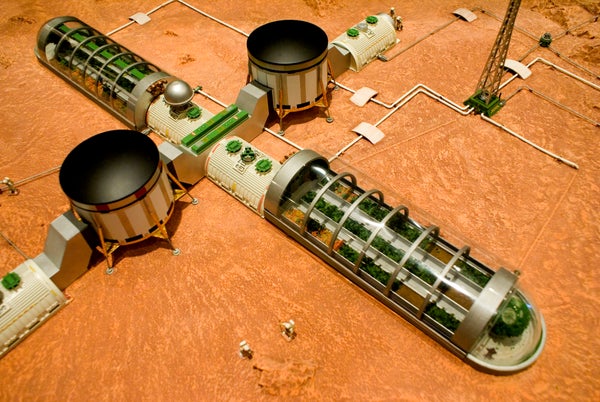This article was published in Scientific American’s former blog network and reflects the views of the author, not necessarily those of Scientific American
This may not be the right time to bring this up, but let’s just say it: there’s strong reason to believe illnesses like COVID-19 might become more prevalent in coming years. When we encroach on previously untouched areas—such as wild lands, dense jungles and tropical forests—we unleash unknown viruses that our bodies have no protection against. As the human population grows and natural habitats shrink, this cycle will likely continue. Other catastrophic dangers to Earth include collisions with asteroids and comets, global thermonuclear or biochemical warfare, and of course the long-term effects of global warming.
To lessen these dangers, we might need to get away. Far away. Like all the way to Mars. The primary reasons for going are to explore and to search for life—both past and present. But settlements on Mars also provide a safe haven for humankind in the unlikely event that something catastrophic happens to the Earth. Going to Mars isn’t just fanciful, pie-in-the-sky thinking. NASA is under presidential orders to land humans on Mars by 2033, and the organization is studying ways to build human habitations on the Red Planet. In 2016, SpaceXpublicly announced a comprehensive vision to begin building settlements on Mars, proposing a high-capacity transportation infrastructure. This two-phase mission could put people on Mars by 2026.
This potential colonization is why astrobiology students at Villanova began their Mars Gardens project, investigating which plants and vegetables can grow in iron oxide–rich Martian soil simulant (MSS). Over 45 different kinds of plants have been tested since the program began in 2017—and, given that these are college students, it’s unsurprising that the tests included hops and barley.
On supporting science journalism
If you're enjoying this article, consider supporting our award-winning journalism by subscribing. By purchasing a subscription you are helping to ensure the future of impactful stories about the discoveries and ideas shaping our world today.
Plants grown in potting mix under the same environmental conditions served as “controls,” and the simulant regolith (soil) is based to a large extent on volcanic rock from the Mojave Desert. MSS, which tends to be denser, is available online and comes from NASA’s chemical analysis of Martian samples. However, the actual regolith on Mars contains perchlorates that are dangerous to humans. So, once on Mars, this hazardous chemical will have to be removed before the actual soil is used. Also, the sunlight on Mars is weaker, which affects growing conditions. So, the Villanova students took all the right steps to replicate Martian greenhouse conditions, and accounted for as many variables as possible—all with the goal of answering the question: Can plants be grown on Mars in Martian soil under reduced ambient light?
THE UNWELCOMING PLANET
Before we answer that, let’s take a big-picture look at Mars. It’s safe to say the environment there isn’t exactly welcoming: Overall, Mars is small (about one 10th of Earth’s mass), cold (on average, –50 degrees Celsius) and desolate. It has a very thin, carbon dioxide–rich atmosphere that’s about one 90th as dense of Earth’s. Mars is roughly 141 million miles from the sun (Earth is 93 million miles), meaning the maximum intensity of sunlight on Mars is about 43 percent the strength of the sunlight on Earth. There is some good news, however, as beneficial carbon dioxide and nitrogen make up about 95 percent and 2.6 percent of the planet’s atmosphere, respectively. However, without any ozone in the Martian atmosphere, the greenhouse windows would need to block harmful solar ultraviolet radiation.
A few billion years ago, Mars boasted a more hospitable environment, complete with oceans, a temperate climate and—quite possibly—life. It has since lost most of its atmosphere and water inventories, and there is currently no water on its surface. Water (or ice) is present beneath the surface, however, as well as in the planet’s icy polar regions. These harsh conditions make it necessary for all plants to be grown in heated, pressurized greenhouses with significant compensations made for atmosphere, humidity and water.
In their greenhouse experiments, the Villanova students took strenuous measures to create an environment that’s both plant-friendly and similar to what would be found in greenhouses on Mars. They ensured, for instance, that plants received roughly the same amount of sunlight as they would on Mars. Given these requirements, the students also experimented with growing some plants hydroponically.
The students found that their success rates could be improved with two enhancements: augmenting sunlight by using multiwavelength LEDs and loosening the dense MSS by adding potting soil—or earthworm feces.
Based on all these factors, students were able to eliminate certain vegetables from consideration. For instance, the low light on Mars does not lend itself well to growing plants that require full sun, which include favorites like tomatoes, beans, legumes, corn or many root plants. Carrots also don’t make the cut, as they tend to come out stunted in the claylike MSS. Potatoes largely don’t thrive in the simulant soil and low light conditions, but sweet potatoes do a little better.
The students found that dandelions would flourish on Mars and have significant benefits: they grow quickly, every part of the plant is edible, and they have high nutritional value. Other thriving plants include microgreens, lettuce, arugula, spinach, peas, garlic, kale and onions.
Conditions on Mars for humans, let alone farmers, are far from easy. The difficult planet certainly isn’t a natural home for us, and growing sustenance there would be a complicated task. That said, it’s not impossible, and it’s comforting to know that we could develop and maintain our own sources of food on a distant landscape. The possibility of growing hops and barley doesn’t hurt, either.
